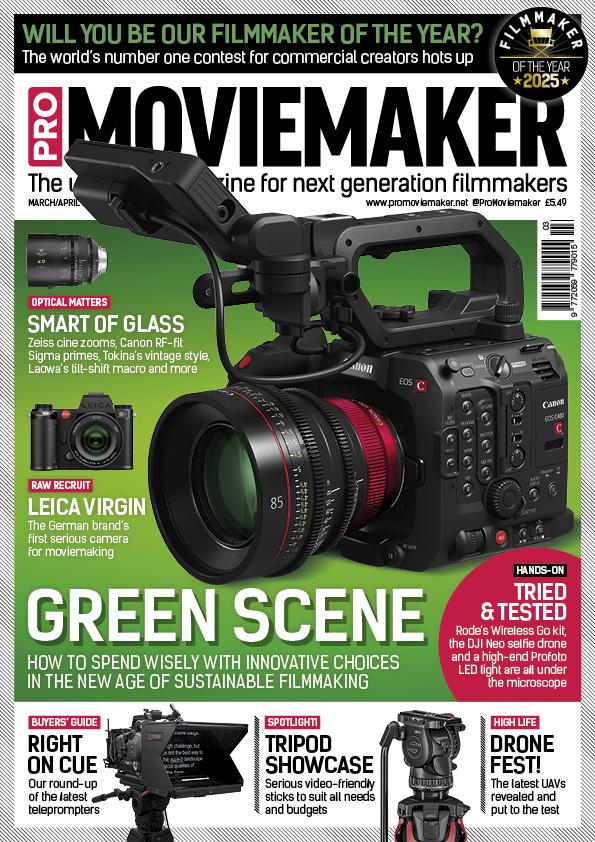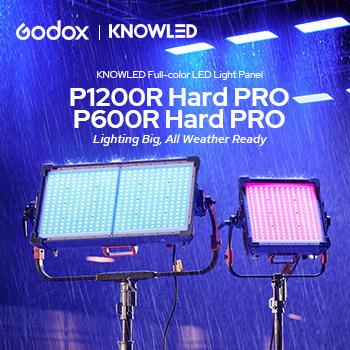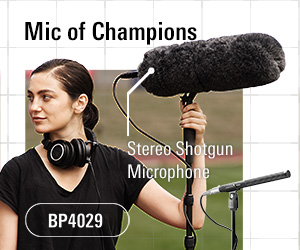
Sony Z200 Test
Posted on Sep 24, 2024 by Pro Moviemaker
All Present and Connect
Sony’s new Z200 is a do-it-all camcorder which now has live streaming and connectivity built-in
Cast your mind back five years and the world was a different place. Nobody had heard of Covid-19 and, although live streaming was just about making inroads, most pro camcorders were exclusively used for recording events to be edited for viewing later.
Nowadays, that is still important but has declined. What has exploded is the need for streaming events as they happen while still recording high-resolution footage for later.
With this boom in streaming has come a widening of the user base. There are still multicamera shoots run by experienced professionals, but often smaller events are shot and streamed from a single camera by people with far less experience. Beginners, even.
So when Sony decided it was time to revamp its five-year-old Z190 camera, the belief was that the new version had to be better than the current model for high-quality recording, and leagues better for streaming too. But it had to be equally usable for multicamera pros and newbies. That’s a big ask.
What Sony didn’t do with its new model, called the Z200, was make it look significantly different to the older camera. It still has the tried-and-tested form factor of a fixed-lens camcorder and even takes the same BP-U batteries that lots of people already own.
But inside, the Z200 really is all-new – starting with the sensor itself. The Z190, and its big brother Z280, were the first in the world to offer 4K from a three-chip set-up. This technology uses three smaller sensors to separately record the red, green and blue information, which is then digitally combined to create the final footage. This gives improved image quality and lower noise than just one sensor of the same size, and it helps create a greater depth-of-field. The theory was not everyone valued shallow depth-of-field, certainly when capturing events.
But now it’s more in demand, so the Z200 has a single, larger 1.0-type, 14-megapixel CMOS sensor. This reduces noise and improves quality, while allowing for a more cinematic look.
The larger sensor calls for a different focal length and the 3.7-92.5mm zoom of the Z190 is now replaced by the 7.7-154.2mm on the Z200. This gives the equivalent of a 24-480mm lens when converted to 35mm format, which is a 20x range and slightly smaller than the 25x range of the older camera (28.8mm-720mm). But the difference at the wider end is much more usable to cram things in and is a major step forward. You’re less likely to need a wide-angle converter.
And the digital zoom can boost the longer end of the Z200’s reach to 720mm in 4K or 960mm in HD. That’s simply incredible. You might not be able to fit other lenses, but chances are you’d never need to. The lens has three separate control rings for focusing, zooming and setting the iris. Or you can zoom with the powered rocker switches on the top of the body and the side handle.
The left side of the camera body packs in all the typical Sony controls used on cinema cameras and camcorders. There are menu buttons, lots of user-assignable buttons, push AF and proper audio-control dials. There are two record buttons; one on top and one on the handgrip. When we tried the Z190, we said it was a shame there wasn’t a third on the left side of the body, which would make it more useful when on a tripod. There still isn’t one on the new Z200.
What the camera now has is a clear button where you select auto or manual. Inexperienced users can stick to auto and the camera does it all in 4K. Experienced operators can go all-manual and change everything. And if you are a manual user but suddenly need a grab shot, flicking the camera to auto means you are up and running in seconds.
Chances are that readers of Pro Moviemaker will be using the manual setting, and accessing the menu system which has the same basic look and feel of Sony’s cinema cameras and camcorders. If you are a Sony user then you will quickly get to grips with it, but beginners will have a steep learning curve. This offers all the controls of pro-level cameras plus lots more screens added to set up streaming.
The left side of the body also has the variable ND filter system which can be adjusted using a dial-wheel or set to auto. So you can keep your shutter speed and aperture constant for a desired depth-of-field and alter exposure using the ND wheel. It’s fast and simple and is ideal for fast-paced ENG-type use.
Sony’s MI Multi Interface connector sits on the top and allows attachment of dedicated accessories, like a wireless receiver, which work without any cables. As the camera can record four audio channels, you can use two via the MI Shoe receiver and two via the full-size XLR inputs on the right of the camera.
The Z200 has a decent viewfinder touchscreen that’s an 8.8cm/3.5in LCD, as well as a viewfinder which is bright and detailed.
The camera has HDMI and SDI for outputting footage, with the Z190’s lower-spec 3G-SDI being replaced by 12G-SDI output that’s four times the bandwidth. So you can output 4K via SDI, where on the Z190 you needed to go via the HDMI as the 3G-SDI won’t cut it.
This camera is made for 4K quality and if you stick to 50/60p, the 4K is oversampled from the 5K readout in All-Intra, 4:2:2 10-bit quality. The camera offers lower-quality such as 4:2:0 in Long GOP and you can record in 4K/120p or 240p in HD. S&Q mode allows up to 5x slow motion but is recorded without audio. And Sony says a conventional broadcast-style XAVC in an MXF wrapper will be added in a future upgrade.
There is no arguing over the image quality – it is excellent, especially in good light. When light drops and you have to dial some gain in, there is some noise as you’d expect, especially as the lens can go wider than f/2.8 at the wider end. Some noise reduction software cleans it right up though. But in typical use in good light, the footage is highly detailed, with natural colours and very low noise with plenty of information in the shadows and highlights, too.
The camera offers various flavours of 709 colour and also S-Log3 for even more dynamic range – as well as the very useful S-Cinetone which gives a more cinematic look right out of camera. All of Sony’s pro models offer this and it’s a very clean look that’s not too stylised. It’s our go-to setting when there isn’t time for a full colour grade. The camera also offers different strengths of HDR.
To record the highest-data codecs, the Z200 uses a pair of CFexpress Type A cards which can be pricey. But these card slots also accept cheaper, standard SD cards if you don’t need the all-singing codecs. And most users don’t.
The Z200 is packed with Sony’s newest tech including Fast Hybrid AF with phase detection. Although manual focus is traditional, autofocus is vital on ENG and events cameras and the Z200 moves it on from the older model.
Sony’s advanced AF system has focus points covering 98% of the width of the frame and 82% of its height, to provide tracking that’s responsive. There is face detection technology that works well and now human pose estimation AI, which uses its own processing unit. This uses deep-learning technology to recognise human bodies and tracks them even if the person moves out of shot and back in, turns away or has their face covered. It works better than you might imagine. You can also adjust AF transition speed and subject-shift sensitivity to customise the AF operation.
The AF tracks its subjects well, and the focus point can be selected by touching the screen. We tried this for some focus pulls but it wasn’t perfect, so switching to manual focus was needed in situations where contrast was low.
The AI processor can also auto- frame a subject. You set the camera to a wider focal length to take in all the areas your subject might be in. The camera crops into the scene to keep your subject in the centre of the frame, even if they move around. It’s ideal for users who want a multicam set-up but don’t have enough operators, although it’ll probably be popular with self-shooting vloggers.
Other new tech includes a Nightshot function where the camera can record in almost total darkness and produce footage in a natural-looking black & white. Ideal for wildlife or newsgathering, especially with the long lens.
But it’s in connectivity where the camera really shines. Sony’s newest Monitor & Control app lets you use a smart device as a wireless remote monitor, offering waveform, false colour, zebra and histogram tools as well as control over most camera settings. It’s fast and simple and many Sony users already have it with other cameras in the range.
For streaming, there are lots of options using the built-in technology. It can direct stream over a WAN using the common RTMP/S system or the newer SRT protocol, which offers very low latency. Just key in the Wi-Fi access passwords and where you want to stream to in the camera’s menu, and you’re ready to broadcast to the world. It’s the system used by YouTube and Facebook Live and it will tether over USB or via Wi-Fi to a computer.
If you want more options, the camera is compatible with Sony’s PDT-FP1 Portable Data Transmitter – this uses SIM cards to stream in 5G via mobile networks out in the field. Or add on the CBK-RPU7 Remote Production Unit for connection via the 12G-SDI port.
To get footage out to members of your team who may want to start on an edit, the camera supports uploads via a smart device to Sony’s Creators’ Cloud for Enterprise. This offers storage, switching via the cloud and editing functions online. There is also support for FTP servers, with XAVC S and HS footage as well as proxy files all supported.
And it’s in the modern workflow that this camera sets itself apart from its predecessor. As a camera to record top-quality footage in 4K, the Z200 is definitely a step forward from the Z190 in many ways. But in terms of streaming, networking and connectivity, it’s a giant leap ahead.
The Verdict
If you’ve lived with the Z190 for years, you’ll know it is a very capable camcorder that’s ideal for recording events and can be used for streaming effectively, too.
But the Z200 is a better tool when it comes to the former, with higher-quality footage, better AF, more effective image stabilisation and a few cool AI tricks.
The Z190 has fallen behind not only when it comes to recording footage to cards, but also live broadcasting it, uploading it to the cloud for sharing or even for live switching. For that, the Z200 is light years ahead and surely worth the upgrade.
However, if you don’t need 12G-SDI, broadcast-ready MXF wrapper in XAVC, timecode or compatibility with the Remote Production Unit, Sony also now has the NX800. This camera is identical in looks and spec to the Z200, but without these higher-end options and is cheaper at £3035/$3300. And that makes it a bit of a bargain.
Features: 9
Packed with the latest spec and ideal for streaming
Performance: 9
It is a do-it-all solution that produces great results
Handling: 9
Sony has the know-how in building camcorders for professionals
Value for money: 8
The Z200 offers it all but is not a cheap option
Overall rating: 9/10
A fixed-lens camcorder that can be used by pros and amateurs
Pros: Touch-tracking AF, easy streaming, simple to use
Cons: Not everyone uses CFexpress Type A media
This feature was first published in the September/October 2024 issue of Pro Moviemaker.












